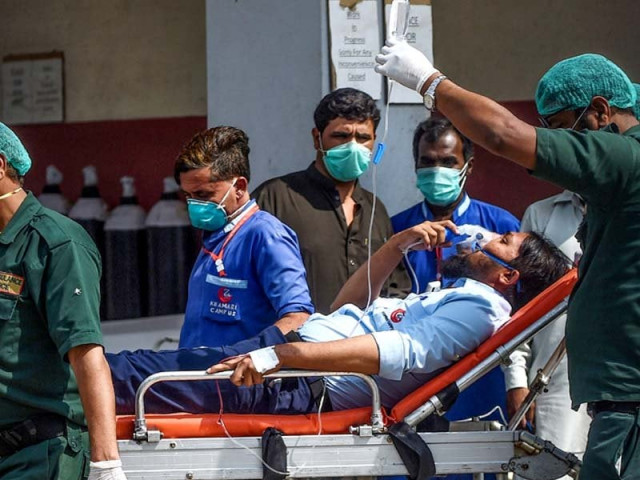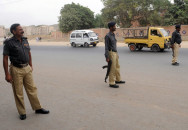Keamari gas leak: ‘No toxic elements found during forensic investigation’ — experts
Reports suggest patients contained abnormal levels of immunoglobulin E, which causes allergic reactions

Paramedic staff shifts a patient on a stretcher into the hospital in Karachi on February 18, 2020. PHOTO: AFP/ FILE
To that end, the International Centre for Chemical and Biological Sciences (ICCBS) has issued a detailed report about the alleged gas leak in which it has been claimed that the blood and urine samples of patients from Keamari had no traces of common industrial toxic elements. However, the presence of immunoglobulin E (IgE) was much higher than the maximum limit.
An immunoglobulin E (IgE) test measures the level of IgE, a type of antibody. Antibodies are made by the immune system to protect the body from bacteria, viruses, and allergens. Small quantities of IgE antibodies are normally found in blood but higher amounts can be a sign that the body overreacts to allergens. This can lead to an allergic reaction.
On the other hand, reports circulating on Pakistani social media claimed that methyl bromide - a chemical used as a pesticide to clean up soil and buildings - was sprayed on the used-garments containers while phosphine, which is a toxic gas, was used on the cargo ship. However, no evidence has been found related to either of the two substances.
Dr Shakeel, a scientist from the ICCBS told The Express Tribune that he visited the site and examined the blood and urine samples of residents and shared that since they were not given access to any other area except for containers carrying used garments and soybean by the Karachi Port City, a forensic investigation should be carried out by foreign experts for further clarity on the matter.
“We toured the site from 2am to 6am and collected samples.” He explained. “A comprehensive investigation is possible only when we are provided with the correct data about the concerned containers. Hence, based on that, we have recommended that a comprehensive forensic investigation should be carried out by international experts.”
Providing further details, Dr Shakeel said that a cargo ship was fumigated with phosphine on January 8 when it departed from the US. The ship reached Pakistan on February 16.
“Phosphine is a gas and it cannot stay in the container for nearly 40 days,” he said. “Therefore, this gas did not cause the deaths in Keamari.”
To prove his claim, Shakeel provided previous examples and said that six children had died due to the same gas, sprayed during pesticide fumigation, in the Qasr-e-Naz (government rest house) incident.
“The gas has a very specific smell and it is heavier than air because of which it does not rise too high in the air. Moreover, methyl bromide was not sprayed on used garments either,” he said.
“Our team even checked the clothes outside the container and found them devoid of the gas. The gas comes in a cylinder and is highly toxic,” he said. “We also inspected the area where soybeans are being packed. The KPT Chairman also showed us its video,” he shared.
The report, which is duly signed by ICCBC director Dr Iqbal Chaudhry, stated that no evidence of common industrial toxic content, methyl bromide, phosphine, hydrogen sulfide were found in the blood and urine samples of the patients during chemical and biological analysis.
According to the report, soybean has caused asthma among people in various port cities of the world, including Barcelona and Valencia, New Orleans. The report has been sent to local authorities.
Published in The Express Tribune, March 6th, 2020.



















COMMENTS
Comments are moderated and generally will be posted if they are on-topic and not abusive.
For more information, please see our Comments FAQ